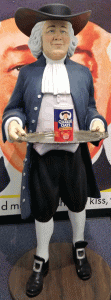Many people wonder about a Fanciful Trademark? Why should anyone want a fanciful trademark?

Quaker Oats, as a stylized mark, is an example of a strong distinctive pictorial trademark, incorporating a distinct image of a man on its products.
Generally, trademarks help consumers distinguish one product or service from another by acting as a source identifier. It helps consumers wanting to purchase Quaker Oats branded oatmeal purchase Quaker Oats and not some “knock-off.”
Trademark protection offers greater protection for stronger marks and less protection for weaker marks. Generally, stronger marks are marks which are distinctive and weaker marks are marks which are descriptive. Fanciful, Arbitrary and Suggestive marks are strong marks which are typically considered distinctive enough to receive trademark registration on their own.
Fanciful trademarks are marks which are typically made up and only have meaning when applied to a good or service. An example of a fanciful trademark is Exxon or Xerox. The words themselves have no meaning other than to indicate a brand of product.
The next strongest type of mark is an Arbitrary Mark, which is a mark which has meaning but as applied to a particular good or service, is unrelated. An example of an arbitrary mark is Peter Pan for peanut butter. Peter Pan is a name of a children’s character in a book but as applied to peanut butter, it has no particular meaning. As to peanut butter, it is distinctive.
Suggestive Marks are considered the next strongest because they suggest some character or quality of the good or service. Suggestive Marks do not describe the good or service, but require some form of imagination on behalf of the consumer to associate the mark with the good or service. Suggestive marks are also protectable, but not as much as Fanciful or Arbitrary Marks.
Descriptive Marks describe the particular good or service and are protectable after a showing of sufficient good will. An example of a descriptive mark is Bank of America. On the other hand, Generic marks are not protectable because they are simply a common name for the product or service. An example of a generic mark would be lite beer for light beer.
If you have questions about choosing a strong trademark, please contact our office to schedule a meeting with one of our trademark attorneys.
